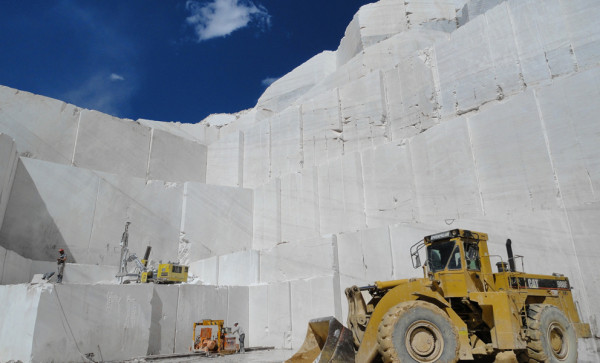Marble is a metamorphic rock, consisting mainly of calcium carbonate aggregated in a crystalline filling, which is veined by additional minerals leading with their veins to the different varieties.
This bright stone (it owes its name to the Greek word "marmairo", meaning to shine) formerly drew already the attention of the ancient romans, who began the excavation with techniques which remained unchanged till the invention of the gun-powder.
With sledge-hammers, axes and chisels they made some clefts where they inserted wooden wedges, which, when once wet, exerted such pressure that the blocks were cut from the mountain. The size of these blocks was of course smaller in comparison with those obtained by present excavations. The introduction of gun-powder was a remarkable progress: it allowed to pull down a great quantity of unrefined rock, which was then manually squared. On the other hand this technique damaged irreparably the slopes of the mountains and provoked the creation of huge quantities of unusable waste matters, forming the typical "ravaneti" (marble stony paths).
The introduction of the helical wire, at the end of the 1800s, represented a real revolution: it is a long wire with a diameter of 5 mm consisting in 3 small steel cables wound up and extending, through a series of returning pulleys, into the whole area of the quarry.
The wire, which was moved by an electrical engine, was placed on the rock to be cut, where there was also an abrasive mixture of water and siliceous sand, which engraved the rock. The wire was only used to remove the mixture and the heat of the friction was dispersed on the way of the wire itself, which covered many hundreds of meters and was often contemporary used for more than one cut.
This cutting system continued till the beginning of the nineteen-eighties, when it was replaced by the cutter machine with the diamond wire, the actual more widespread cutter machinery.
It is an engine which moves a steel cable with small diamond pearls, passing inside the rock to cut thanks to piercing machines. As the wire cuts the rock, the motor-pulley moves back to keep the wire itself in tension. In these last years the chain cutter machine has made its appearance: it consists in a long metal arm, on which a toothed chain runs. The arm is connected to a motor-block running along the tracks.
With this machine marble is literally "sliced": the blocks are very regular already in the large squares of the quarry yards. The huge increase in excavation velocity has had positive consequences on the marble's economy, but has created worse environmental problems, concerning the impact of the quarries on the territory. The production of "marmettola" (marble-dust) and of other waste matters, which are discharged in the "ravaneti" has actually increased.
The marble blocks are today transported down to the plain with motor-vehicles going up and down through breakneck mountain roads. Once, till the end of the nineteen-sixties, the quarrymen used the old system of the "lizzatura", which was already used in the Roman Age. The blocks were placed in a kind of wooden sledge (the "lizza") and let down in breakneck slopes putting some soaped wooden cross-pieces ("parati") under the lizza. The whole was held back by strong hemp ropes and from the nineteen-twenties by steel cables wound on strong wooden stakes ("piri") which are drived into the rock (parati).
Brave companies of "Lizza" were entrusted with this dangerous activity and had to carefully organice their work. Over the charge there were the "mollatori" (mollare = to let go): they had to let the ropes holding the structure progressively go. In front of the charge there was the lizza's leader, who was responsible of the group and who had to insert the "parati" under the lizza to allows its running and guided the descend giving the orders to the "mollatori"; sideways a group of two, three men continually took the parati behind the lizza and gave them back well-soaped to the leader.
Today this ancient practice has disappeared but there remain in the territory the Lizza Ways to testify the incredible routes falling steeply to the plain, with differences in height of over 1000 m

